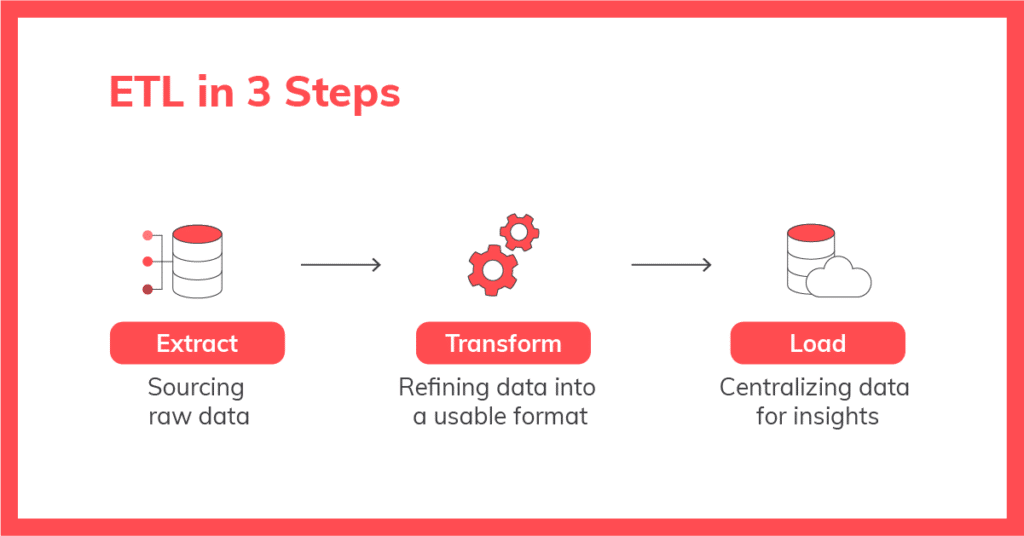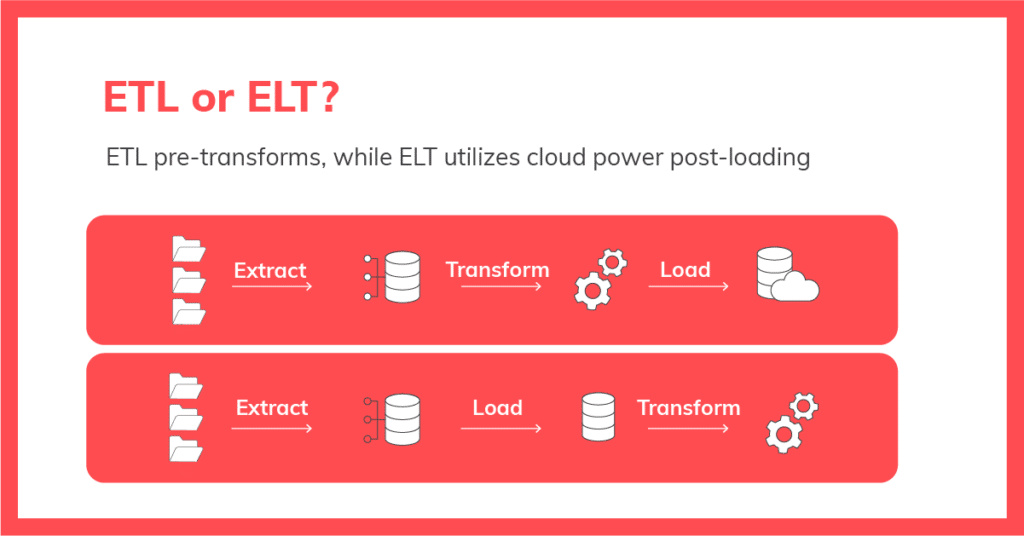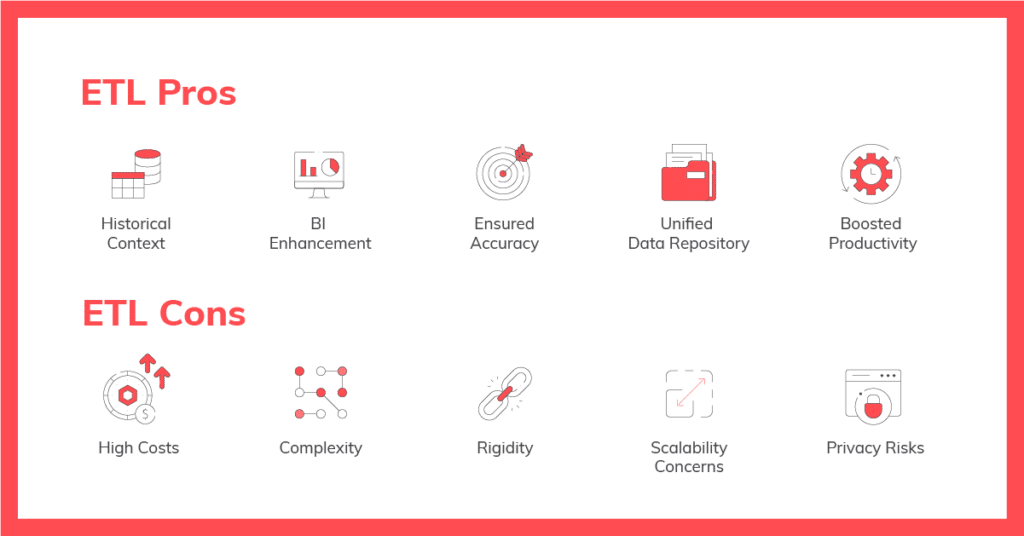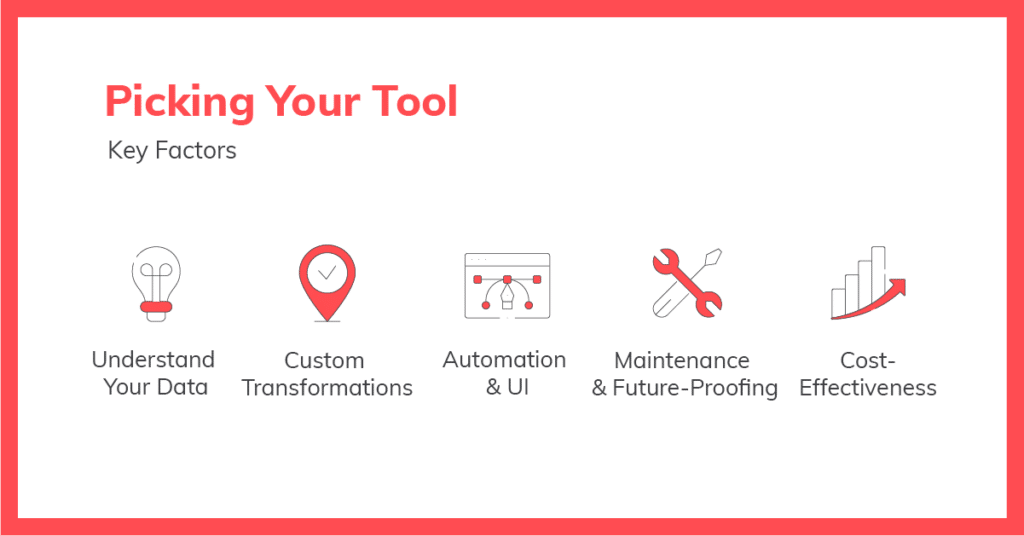What’s the difference between ETL & ELT?
ETL (Extract, Transform, Load) transforms data before loading into a warehouse, ideal for legacy systems and high-security needs. ELT (Extract, Load, Transform) loads raw data first, leveraging modern cloud data warehouses for scalability. Choose ETL for structured, smaller datasets; ELT suits large, diverse data types in agile workflows.
Article Updated November 15, 2024
Data now anchors the core of numerous businesses, making data integration one of the main challenges to solve. For data engineers, much of their work revolves around transporting data via pipelines, often defined as either ETL or ELT. While ETL has stood as the standard for pipeline management for years, the rise of cloud technology tilts the scales towards ELT.
This article dives into the difference between ETL and ELT, tracing their evolution and pinpointing their distinct applications, helping you discern which fits your needs best.
ETL vs ELT: What's the Difference?
In data integration, ETL and ELT are both pivotal methods for transferring data from one location to another.
ETL (Extract, Transform, Load) is a time-tested methodology where data is transformed using a separate processing server before being moved to the data warehouse.

Contrarily, ELT (Extract, Load, Transform) is a more recent approach where raw data is directly transferred to the data warehouse, and transformations occur within its confines, bypassing the need for intermediary staging processes.

Therefore, the primary difference between ETL and ELT hinges on the location of data transformation. In the ETL process, data is extracted from its source and then transformed externally on a separate processing server before it’s loaded into the data warehouse. This method ensures that only processed and refined data enters the data warehouse, leaving raw data outside its confines.
On the other hand, ELT takes a slightly different route. With ELT, data is first extracted from its origin and loaded directly into the data warehouse in its raw form. It’s only after this loading step that the data undergoes transformation, all of which occurs inside the data warehouse itself. As a result, ELT retains both the raw and transformed versions of data within the warehouse, providing a richer historical context that can be invaluable for certain business intelligence applications.
From this foundational difference in the location of data transformation, several other distinct characteristics and implications arise for both ETL and ELT. The following table provides a comprehensive side-by-side comparison to highlight these nuances.
Category
ETL (Extract, Transform, Load)
ELT (Extract, Load, Transform)
Definition
Transforms data using a separate processing server before transferring to the data warehouse.
Directly transfers raw data to the data warehouse; transformations occur within the warehouse.
Order of Operations
Extract → Transform → Load
Extract → Load → Transform
Processing Environment
Transformation on a dedicated server or intermediate system.
Transformation directly within the data warehouse.
Data Latency
Higher due to transformation before loading.
Typically lower as data is loaded first, transformations can be scheduled later.
Flexibility
More controlled transformation process.
Offers agility and adaptability, especially with modern data warehouses.
Complexity
Can be intricate for complex data integrations.
Simpler loading process, but might require robust warehousing tools for complex transformations.
Use Cases
Ideal for legacy systems, smaller datasets, and high data security needs.
Best for cloud-based environments, diverse data types (structured / unstructured).
Speed
Might be slower due to the staging and transformation processes.
Faster initial loading; transformation speed varies based on warehouse capabilities.
Privacy
Enhanced data security due to controlled transformation.
Data privacy depends on warehouse security measures; raw data directly loaded.
Maintenance
Requires maintenance of the ETL server and transformation processes.
Primarily centered around maintaining the data warehouse and its transformations.
Cost
Can be higher due to dedicated servers and transformation tools.
Costs revolve around data warehousing; can be lower with cloud-based solutions.
Data Volume
Suitable for smaller to medium datasets.
Ideal for handling larger volumes of data, leveraging modern warehouse scalability.
ETL to ELT Evolution
Understanding ETL's Origins
Read More: What is ETL? – (Extract, Transform, Load)
Drawbacks of ETL
- Expensive to Implement and Maintain: ETL isn’t a walk in the park. Implementing it can take months, with continuous tweaks following suit. This complexity often forces businesses to hire specialists for the job.
- Rigid-in-Nature: ETL is structured. Transformations occur in a staging area between the source and destination, ensuring data format consistency but hindering the rapid processing of vast data volumes. Also, it demands that analysts predefine their data usage strategies, which can lead to format-related complications.
- Slow to Provide Fresh Data: ETL lags in delivering fresh data. Transformations precede data loading, making ETL less agile in managing today’s data influx. Often, ETL processes get relegated to nighttime slots, denying analysts access to real-time data.
- Low in Visibility: Users see only the transformed, loaded data, not the raw version. This myopic view can lead to misinterpretations, especially if data gets reshaped during transformations.

The Shift to Cloud
With time, as cloud computing and big data technologies became more prevalent, the ETL paradigm began to shift. The compute power and storage capabilities offered by the cloud, combined with the sheer volume and velocity of data, paved the way for the emergence of ELT (Extract, Load, Transform), where transformations are handled directly within the data warehouse. And here is where the ETL vs ELT dichotomy arose.
This shift to ELT was also influenced by the rise of modern, cloud-native data warehouses like Snowflake, BigQuery, Azure, and Redshift. These platforms provided the scalability and performance to handle transformations on massive datasets after they had been loaded.
Advantages of ELT
With the new, fast data cloud warehouses, data professionals are able to perform their transformations in the warehouse itself Below are the advantages:
- Agile: Software engineers deploy multiple times per day — praising continuous delivery. The same principle guides data transformations in the ELT process. When the input data or the metric definition change, you can easily implement these transformations in hours, not weeks or months.
- Scalable: With decreased reliance on on-site storage and the falling costs in cloud-based solutions, ELT leverages cloud storage, putting transformations at the end and allowing for endless scalability.
- Decision-making Centric: Modern data warehouses are built for vast data storage and analysis. Analysts using ELT don’t have to prematurely decide on reports or schema. The warehouse, a consolidated data hub, gets a direct source data copy, ensuring analysts work with genuine, uncompromised data.
How to Decide When to Use ETL vs ELT
Data integration is pivotal for businesses to glean insights, foster decision-making, and streamline operations. Both ETL and ELT play crucial roles in this domain, but their application can vary based on specific use cases and requirements.
Since the ETL vs ELT dichotomy still causes confusion, here’s a comprehensive look at when and why one might be favored over the other:
ETL Use Cases:
Legacy Systems: ETL fits seamlessly with older systems that may not be equipped to handle on-site data transformations, offering a dedicated transformation process.
Smaller Datasets: When dealing with relatively smaller data volumes that require intricate transformations, ETL can prove efficient.
High Data Security Needs: ETL’s structured and controlled transformation process can offer enhanced security, especially when handling sensitive data.
Diverse Data Sources: When integrating data from multiple disparate sources, ETL’s transformation phase can harmonize and cleanse data before loading.
ELT Use Cases:
Modern Data Warehouses: Cloud-based and advanced warehousing solutions like Snowflake or BigQuery can leverage ELT’s potential, performing transformations after data loading.
Large Data Volumes: ELT can swiftly handle vast amounts of data, leveraging the scalability of modern warehouses.
Real-time Analytics: Since ELT involves faster initial loading, it can support near-real-time analytics, transforming data on-the-go.
Adaptable Data Processing: ELT’s flexibility caters to both structured and unstructured data, providing analysts with the liberty to mold data as required.
Guiding Data Teams in their Choice:
Assess Infrastructure: If your organization primarily operates with legacy systems, ETL might be more fitting. However, for modern, cloud-based infrastructures, ELT can be more apt.
Data Volume and Velocity: Consider the amount and speed of incoming data. Larger, more rapid data influxes might favor the ELT approach.
Security Concerns: If data privacy and security are paramount, a controlled ETL process can offer added peace of mind.
Transformation Complexity: Evaluate the intricacies of the required transformations. Complex, multifaceted transformations might be better suited to ETL, while ELT can handle more straightforward, on-site modifications.
Cost Implications: Take into account the potential costs of dedicated transformation servers (ETL) versus modern data warehousing solutions (ELT).

In conclusion, while both ETL and ELT offer their unique advantages, it’s essential for data teams to align their choice with their specific needs, infrastructure, and long-term data goals. By weighing the pros and cons of each approach and understanding their distinct use cases, organizations can pave the way for efficient, insightful data integration.
Read More: Zero ETL: What’s Behind the Hype?
Navigating the Future of Data Integration: Beyond ETL and ELT
Overall, ETL and ELT share the same goal, but the infrastructure underlying each process is vastly different. Generally, ELT will be the process that best fits modern companies’ data needs. However, there are specific use cases where ETL might be the right choice.
Understanding the difference between ETL vs ELT is only the beginning of truly understanding what you can do with data in an ever-changing environment of technology and tools. ETLT is the newest paradigm to explore. Contrary to ELT, ETLT totally decouples the extract and load steps from any potential optional transformation.
Each operational use case is distinct in how it makes use of incoming data. Some could perform sophisticated transformations, while others might not even need to transform at all. As data warehouses advance more and more, we’re sure we will continue to evolve the processes and techniques to extract true value from our data.
Frequently Asked Questions:
ETL vs. ELT
1. What is ETL, and how does it work?
ETL (Extract, Transform, Load) is a data integration process that extracts data from source systems, transforms it on a staging server to meet specific requirements, and then loads it into a data warehouse. It’s best for structured data, smaller datasets, or when compliance and data privacy are critical.
2. What is ELT, and how is it different from ETL?
ELT (Extract, Load, Transform) directly loads raw data into a data warehouse and performs transformations within the warehouse itself. This process leverages modern cloud-native tools, offering faster ingestion, scalability, and support for unstructured data types. Unlike ETL, it retains raw data for historical analysis.
3. Why is ELT better suited for modern data environments?
ELT thrives in cloud-based environments because it uses the warehouse’s native processing power. It supports high data velocity, large volumes, and diverse data types (structured, semi-structured, and unstructured). This makes it ideal for real-time analytics and scalable workflows.
4. When should I choose ETL over ELT?
Choose ETL if:
- You’re working with legacy systems.
- You need rigorous pre-load data transformations for compliance.
- Your datasets are relatively small and structured.
5. When should I choose ELT over ETL?
Choose ELT if:
- You’re leveraging modern cloud warehouses like Snowflake, BigQuery, or Redshift.
- You need to process vast amounts of raw data for agile analytics.
- You require real-time or near-real-time insights.
6. Can I use ETL and ELT together?
Yes, some organizations combine both methods. ETL may handle sensitive or structured data transformations upfront, while ELT processes unstructured or high-volume data within the warehouse.
7. What is Zero ETL, and how does it relate to ETL/ELT?
Zero ETL eliminates traditional data pipelines by enabling direct integrations between operational databases and analytics platforms. This emerging approach reduces latency and simplifies architecture but may not fully replace ETL or ELT in complex use cases yet.





